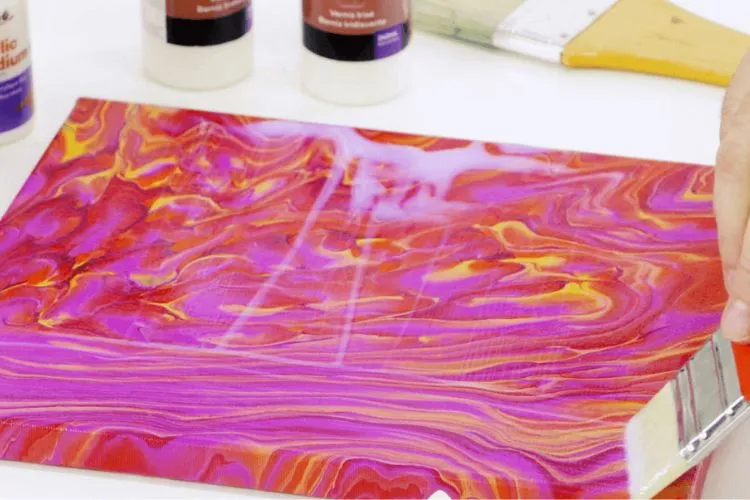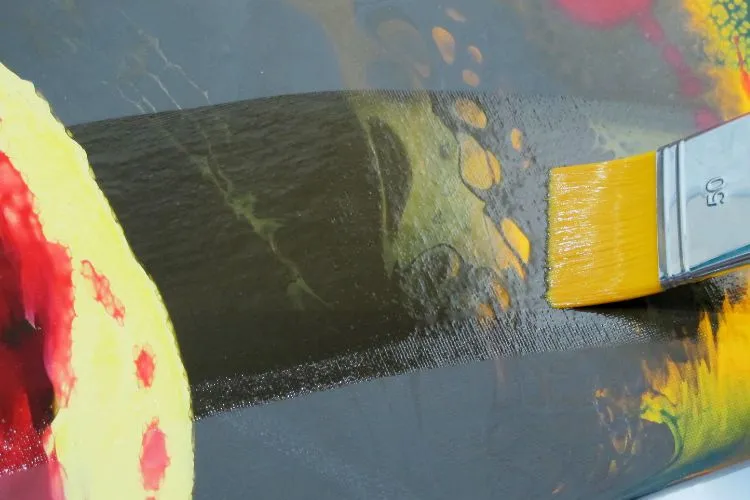Acrylic paint, known for its versatility and durability, is a popular choice among artists for a range of projects. But despite its resilient nature, the question of whether to varnish acrylic paintings arises frequently.
Varnishing serves multiple purposes, from protecting the artwork to enhancing its visual appeal. So, does acrylic paint need varnish?
This article delves deep into the necessity, benefits, and methods of applying varnish over acrylic paint.

Understanding Acrylic Paint
Acrylic paint consists of pigment suspended in an acrylic polymer emulsion. It’s water-soluble but becomes water-resistant upon drying.
Quick drying time and the ability to adhere to a variety of surfaces make it a favored medium for artists. However, the characteristics of acrylics extend beyond their application, influencing decisions made post-painting, such as varnishing.
Does Acrylic Paint Need Varnish?
Varnish is applied over a finished acrylic painting to protect it from dust, UV rays, and other environmental factors. It also physically shields the artwork from potential damage.
Aesthetically, varnish can enhance the colors of a painting, giving it a matte, satin, or glossy finish, based on the artist’s preference.
Varnishing is not merely about immediate appearance but about preserving the artwork over long periods, ensuring colors remain vibrant and the surface free from damage.
To Varnish or Not to Varnish: Making the Decision
Determining whether to varnish an acrylic painting depends on several factors. Where will the painting be displayed? Is it a decorative piece or something more functional, like a painted piece of furniture.
Each scenario might warrant a different approach to varnishing. Without varnish, paintings can suffer from color shifts, exposure damage, and general wear and tear over time.

Types of Varnishes for Acrylic Paint
Varnishes come in two main types: permanent and removable. Permanent varnishes offer long-lasting protection but cannot be easily removed for cleaning or restoring the painting.
Removable varnishes, however, can be taken off without damaging the acrylic paint underneath, allowing for the artwork’s surface to be cleaned or restored.
The finish of the varnish (matte, satin, gloss) affects the painting’s final appearance. A matte varnish can soften colors and reduce glare, while a glossy varnish might bring out the vibrancy in a painting.
Artists can also choose between spray varnishes and brush-on options, each with its application method and resulting texture.
Applying Varnish: Best Practices
Before varnishing, ensure the acrylic painting is completely dry. This might take longer than the surface drying time, as acrylics can retain moisture below their surface. Clean the painting carefully to remove any dust or oils.
When applying varnish, opt for thin, multiple coats rather than a single thick coat. Whether using a brush or spray, apply the varnish evenly and in one direction to avoid bubbles and streaks.
Drying and curing times vary by product, so it’s vital to read the varnish directions carefully. The right environmental conditions will aid in a smooth, clear finish. If issues like cloudiness or color sinking occur, consult the varnish manufacturer for advice on rectification.

Long-Term Care and Maintenance
Maintaining a varnished acrylic painting ensures its longevity, preserving its vibrancy and protection over time. Proper care involves regular cleaning and appropriate storage, which can significantly extend the life and beauty of your artwork.
Here are several tips for long-term care and maintenance:
- Dust Regularly: Use a soft, dry brush or microfiber cloth to gently remove dust from the surface of the painting. This should be done lightly to avoid scratching the varnish layer. Regular dusting prevents the accumulation of grime that can become harder to remove over time.
- Avoid Harsh Chemicals: For deeper cleaning, a slightly damp cloth can be used, but ensure it is not wet enough to leave moisture on the painting. Never use household cleaners or harsh chemicals, as these can degrade the varnish and the underlying paint layers.
- Hang Away from Direct Sunlight: Continuous exposure to UV rays can cause colors to fade and varnish to discolor or become brittle. Display your paintings in areas where they are not in direct sunlight or use UV-protective glass if framing.
- Maintain Stable Environment Conditions: Fluctuations in temperature and humidity can cause the canvas to expand or contract, potentially leading to cracking in the paint or varnish. Try to keep your artwork in a stable and controlled environment, avoiding areas like basements or attics where conditions can vary widely.
- Transport with Care: When moving or storing your painting, protect the surface with acid-free paper or a clean, soft cloth. Avoid wrapping acrylic paintings in plastic for long periods, as this can trap moisture, leading to potential damage. If storing, place in a cool, dry place and ensure it’s well-supported or lying flat to avoid warping.
- Annual Check: Once a year, inspect your painting for any signs of damage or wear. Early detection of issues such as lifting varnish or fading can allow for timely intervention, possibly preventing more extensive damage.
By implementing these care and maintenance practices, your varnished acrylic paintings will continue to be enjoyed in their best condition for many years to come.
Giving attention to the environment in which the artwork is displayed and stored, alongside occasional gentle cleaning, will maintain its integrity and appearance effectively.
Frequently Asked Questions (FAQs)
How long should I wait before varnishing my acrylic painting?
Wait until the painting is completely dry, which can take anywhere from 24 hours to several weeks, depending on the paint’s thickness.
Can I use any type of varnish on my acrylic painting?
While many varnishes are suitable for acrylic paint, using one designed specifically for acrylics is recommended.
How do I know if my acrylic painting needs a second coat of varnish?
Evaluate the coverage after the first coat dries. If the finish appears uneven or lacks the desired protective layer, a second coat might be necessary.
Can varnish be removed from an acrylic painting?
Removable varnishes can be taken off with a solvent, allowing the painting to be cleaned or the varnish layer refreshed.
Conclusion:
Varnishing an acrylic painting is a careful decision that comes down to the needs of the artwork and the artist’s preferences.
It offers protection and aesthetic enhancement but requires precise application. Experimenting with different varnishes and application methods can help artists find the perfect finish for their work.

Meet Isabella Anderson, your acrylic painting mentor with over a decade of brush-wielding mastery. Dive into the colorful world of acrylics with her expert guidance, featured exclusively on ‘Acrylic Authority.’ Unleash your inner artist and explore the limitless possibilities of this versatile medium alongside a true acrylic aficionado.
